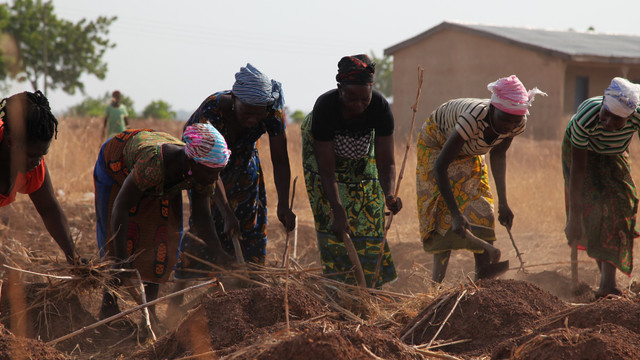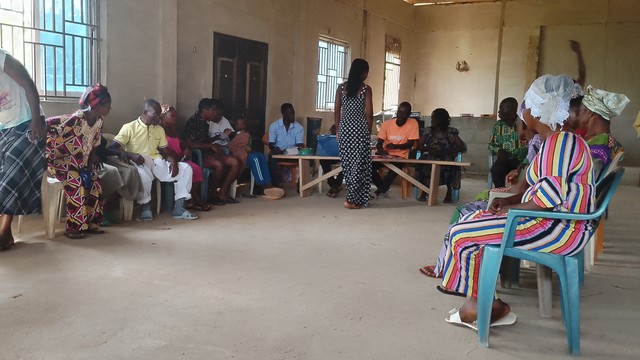Time to move unseen foresters into the limelight
A new report spotlights alternative approaches by which sustainable forest management can deliver more for indigenous people and local communities.



Women cross a river on their way to work in Bardia, Nepal (Photo: copyright James Morgan, WWF-US)
Globally, forests are home to 1.3 billion indigenous peoples and other local communities (IPLCs), including farmers and even forest-product processing clusters on the outskirts of urban areas.
But these communities are often unseen and their important role unaccounted for when rights to forests are decided. A new report from WWF, researched by IIED, shows that sustainable forest management (SFM) benefits when communities living in and around forests, and those who depend on forest resources for their livelihoods, have the right rights and incentives.
Their local models of governance can help protect forests better than many other forms of forest stewardship.
A deeper analytical focus on the means by which SFM can deliver more for IPLCs, to find greater scale and success, is long overdue. More collective power to build agency and prosperity is perhaps the last hope for forests – and for the people who depend on them.
Our new report – 'Unseen foresters: an assessment of approaches for wider recognition and spread of sustainable forest management by local communities – aims to step back from the approach of making SFM work for international markets and provides evidence of alternative approaches that address SFM in both local and global contexts.
Billions of dollars have been poured into international timber trade agreements, tropical forest action plans, SFM certification schemes, forest legality assurance schemes, payments for ecosystem services (PES) and zero-deforestation pledges. Such market-based approaches have helped to improve some elements of large corporate sustainability. But the loss of biodiverse natural forests and land tenure issues related to IPLCs continues.
The Sustainable Development Goals (SDGs), Paris climate agreement, and New York Declaration on Forests suggest change is needed for a cleaner, fairer future. The calls to ‘build back better’ after COVID-19 imply the same. 'Unseen foresters' shows there is a huge variety of innovative approaches that can enable people to thrive and forests to flourish.
Conservative estimates of the gross annual value of smallholder crop, fuelwood and charcoal, timber and non-timber forest products lie between US$869 billion and $1.29 trillion. This is substantially larger than the gross annual value of the largest companies, such as Exxon Mobil ($265 billion in 2019) or Nestlé and Unilever ($150 billion combined). Mobilising the collective potential of IPLCs towards SFM requires coordinated and sustained enabling investments by multiple agencies.
Among forest communities in Africa, Asia and Latin America, we found 13 approaches that can help recognise and spread SFM by IPLCs, as the diagram below illustrates.
Examples include Global Positioning System (GPS)-enabled mapping to secure community forest rights in the Congo Basin, satellite-based remote sensing tree cover reward mechanisms that channel finance to communities conditional on protecting the forest in the Amazon, and participatory guarantee schemes that reduce the costs of certifying SFM for non-timber forest products such as rattan as we found in Borneo.
There is a logic to the way in which each can be built upon one another in concentric rings of opportunity. At the core come approaches that strengthen accountable organisations. These include expanding the practices of local SFM production groups, regional organisations that aggregate, process and market products, and national federations that defend IPLC rights.
Next come approaches that improve landscape governance: the rights and responsibilities of land and resource use and rewards for adopting SFM. Finally come supply chain approaches that can improve business returns for IPLCs from their SFM.
This diagram shows 13 approaches that can support sustainable forest management. Click on the image to enlarge it
Better understanding of how these approaches can build on one another in different contexts can increase positive impacts on forests and people. For example, participatory GPS-enabled mapping of rights can provide the security needed for SFM. This can then be further incentivised through remote sensing tree cover reward mechanisms.
But at present, most approaches are found only in isolated pilot sites, so the power of their combined efficacy is reduced.
Sustainable forest management by IPLCs, including smallholders, is critical to the future of forests. Coordinated action among multiple agencies is needed through innovative approaches that can deliver the transformative change necessary to protect both forests and people. It is time to put the spotlight on supporting and rewarding IPLCs.
This blog first appeared on WWF's Forest Solutions Platform.



